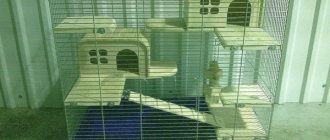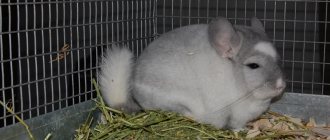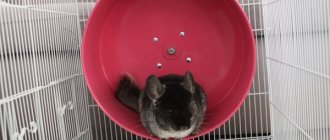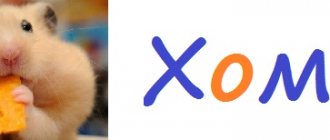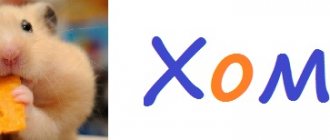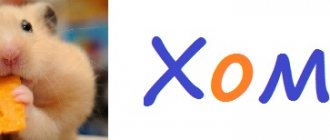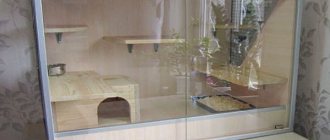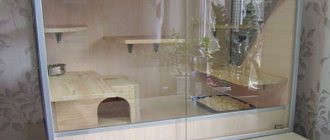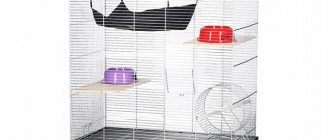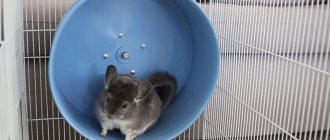Providing a chinchilla with good and proper nutrition is the most important task for its owner. If this is not done, the animal will often get sick, and you will spend a lot of time and money on its treatment. Therefore, it is better to immediately find out which food is best for your chinchilla. Nowadays there is a huge variety of food for chinchillas, so choosing is becoming increasingly difficult.
In this article we will look at what types of food there are for chinchillas and which one is best to choose, as well as a small rating of the most popular foods according to the owners of the animals. The food must contain all the necessary microelements and vitamins for the chinchilla to grow healthy.
Types of food for chinchillas
Two types of dry food are used for chinchillas:
- Regular, crumbly
- Granulated
Both are great for chinchillas, but there are significant differences. Regular food contains all the necessary vitamins and microelements, but the chinchilla will very often choose what she wants to eat. In this case, they can throw aside components that are unpleasant to her taste, which are actually very important for her health.
Granulated food, as you already understood, is granules in which all the components are compressed at once. The chinchilla will no longer be able to select individual components and will have to eat the whole food. In this case, she will definitely receive all the necessary vitamins and minerals.
As we have already understood, granulated food is slightly superior to regular food, but it is often more expensive. Therefore, you will have to decide for yourself what food to give your pet.
Meal schedule
Typically, rodents eat according to a schedule. Therefore, as the reviews say, such a schedule should be created for animals. It is better to feed chinchillas in the evening, since at this time the pet becomes more active.
You should also always monitor the presence of water in the drinking bowl. There is an opinion that chinchillas do not drink water in captivity, but this is just a myth. If chinchilla food is used, a sufficient amount of fluid must be supplied to the body.
Regardless of the diet and food used, there should always be dry grass and hay in the pet’s house. Therefore, it is recommended to make a separate feeder for him.
Pros and cons of feed
Regular food
| pros | Minuses |
| Low price | Chinchilla doesn't eat it completely |
| Available in any store | Sometimes important microelements and vitamins are missing |
| You can do it yourself |
Granulated (compound feed)
| pros | Minuses |
| Eats all the food completely | High price |
| Contains vitamin supplements | Not available in all stores |
| Prevents intestinal diseases |
As you can see, each food has its own disadvantages, but the most important thing is that regular food is cheaper and you can make it yourself if you don’t trust stores. The composition of both foods is approximately the same, but the granulated food contains more useful additives.
Composition of food for chinchillas
It is important to read the composition of the food to make sure that all the necessary components are present in it. And if some of them are missing, then it is necessary to change the food or give the missing vitamins in a different form.
Regular food usually includes:
- Barley, oats and other grains.
- Seeds
- Barley, corn or grass flour
- Bone meal, chalk and other calcium supplements
- Supplements with vitamins, lysine, etc.
The composition is quite simple and you can make this food yourself, read about it below.
Composition of granulated feed (compound feed)
Some call kibble food compound feed, but in reality it is just regular kibble food for chinchillas.
- Cereal products
- Meals
- Herbal flour
- Syrup
- Various oils, for example, vegetable
- Products with calcium, most often limestone
- Premix with vitamins and minerals
- Complex supplements containing all necessary vitamins and microelements
- Probiotics, phosphates, salts, etc.
- Supplements That Prevent Intestinal Diseases
Judging by the composition of granulated food, we see that it is much better balanced and will be an order of magnitude higher than regular food. And most importantly, it contains additives that prevent intestinal diseases, which are very dangerous for chinchillas.
Self-feeding
When forming your own diet at home, you should study the composition of the feed. Or more precisely, how much and what should a chinchilla consume. In the case when the food contains up to 20% protein, then over time the quality of the pet’s fur will begin to deteriorate, the fur will begin to dry out and become like cotton wool. It is worth noting that all reviews from owners say that pets die from diseases associated with the digestive system. It is recommended to use both natural food and granules in the diet. Thus, the food for chinchillas will be balanced.
In nature, a chinchilla eats, as a rule, only grass, roots and other plants. Therefore, at home, hay is preferable for them. The hay itself should contain clover, alfalfa and various legumes, which contain a sufficient amount of protein. How much it should be depends only on the breeder, but the more, the better.
As fresh grass, you can use ordinary grass that grows in meadows, as well as oats and grain sprouts.
Before giving your chinchilla grass, make sure it is clean and free of dew. It is better to feed it in small portions so that it does not spoil. As for berries and vegetables, they can also be included in the diet, but just a little. It is better to feed animals not with succulent food, but with dry food.
To prevent your pet's teeth from growing and wearing down properly, you should also give branches from trees and bushes. It’s better, of course, that they be from the fruit family. You can also pour wheat and barley grain into the feeders.
Composition of premium food and how they differ.
To understand why you pay a lot of money when you buy premium food, you need to carefully read the composition. In this case, premium food from Fiory was used. Almost all premium food is supplied only in granules.
- The basis is taken from useful herbs: Timothy grass, medicinal dandelion, fescue, ryegrass, plantain, common gum, nettle leaves, thyme, shepherd's purse, two types of clover, meadowsweet, verbena, common fragrant spikelet, ragweed, plantain leaves, kupir, foxtail , Bermuda grass, peas, chicory, fennel.
- Quartz sand for grinding teeth
- Mineral supplements, yeast feed and yeast cell walls, chicory inulin, fructose, nucleotides, substances containing omega 3 and omega 6, beta glucan,
- As a result, we get the content of vitamins A, D3, E, B1, B2, B6, B9, B12 and several more.
- Balanced amount of fat, fiber and protein. 12% protein, only 3% fat, 43% fiber, 8% ash.
Unfortunately, this food states that it contains 0% calcium and phosphorus, which means you will have to independently add components that contain them to the diet. It turns out that premium food for chinchillas will not fully satisfy the need for useful components.
But the most important thing is that the composition is very diverse and contains many useful herbs, vitamins and microelements. The cost of such food starts from 400 rubles per pack, which weighs on average 800 grams. If a chinchilla eats 40 grams of food per day, then it turns out that 800 grams is enough for 20 calendar days, respectively, 1.5 packs of food are needed for months. This means you only need to spend 600 rubles per month for 1 chinchilla. I think this is not so much, but if you keep several chinchillas, the costs will be huge.
How to make food for chinchillas with your own hands
To begin with, I will write to you about the pros and cons of food that you make yourself for your chinchillas.
Pros.
- The food will definitely contain all the necessary vitamins and microelements.
- It will always be fresh, and you know exactly its composition
- If the chinchilla does not like certain components, they can be replaced with similar ones
- For each age, season and state of health of the animal, it needs to add different herbs and berries. Sometimes it is necessary to remove overly nutritious components from the diet if the chinchilla becomes obese.
- The food will be much cheaper, but in terms of beneficial properties it will be on par with elite food
There are not many disadvantages
- It is necessary to monitor the condition of the animal until it gets used to the new food.
- You need to buy different components yourself, which are not always easy to find.
What should be included in homemade food:
- It is imperative to have solid grain products so that the chinchilla has something to chew on.
- The base should consist of flour: grass, corn, wheat or barley
- A binding component, for example milk powder.
- There must be calcium, which is contained in lime, bone meal or chalk.
- Special additives. Food sulfur, leaves of nettle or berry trees.
- During cold periods or when the chinchilla is sick, it is necessary to add dry berries and herbs. For example, ground dry rosehip in small doses helps very well; it strengthens the overall immune system.
- Vitamin complexes with microelements, which are sold in any pet store. Their dosage is usually indicated on the package.
Feed preparation process
- Grind the necessary ingredients
- Mix all dry ingredients in any convenient container
- Add water by eye until all ingredients turn into a thick porridge.
- Pass through a meat grinder
- Dry in an electric dryer. You can dry it naturally, but only in very hot weather and low humidity. If mold or rot from moisture forms in the food, then in 99% of cases you will doom your pets to digestive problems.
Prohibited foods in the animal's diet
These include:
- Branches of coniferous trees (they are toxic to chinchillas).
- All citrus products (oranges, grapefruits, lemons, tangerines).
- Animal protein (meat, cow's milk).
- Freshly baked bread and other flour products (considered difficult to digest).
- Roasted seeds, peanuts (harmful to the liver).
- Sugar and all products that contain it (sweets, cakes, waffles).
- Raw tap water (may contain harmful impurities).
DIY food recipe, from one of the chinchilla owners
X: In my city it’s hard to find food; they only bring the cheapest food that is suitable for all rodents. I won’t say anything about its usefulness, because my chinchillas are very reluctant to eat it and have to throw away more than half of the portion.
They liked the granulated food most of all, and its composition was so varied that there was no doubt about its usefulness. There was one problem, it costs a lot of money. Even for 2 chinchillas I had to buy a decent amount; I can’t even imagine how expensive it would be to keep 4-5 chinchillas with such prices for granulated food.
After reading a bunch of literature and decided to make the food myself, but since I love my chinchillas and don’t want to risk them, I decided to show my food to several veterinarians and they advised me to remove some of the components. Along with this, I received some tips on what and when to add to chinchillas at different times of the year, and what not to add.
As a result, I ended up with this feed composition:
- Hay flour
- Medium-ground grains: oats, barley, wheat
- Wheat bran
- Ground corn
- Buckwheat
- Some flax seeds
- Peas
- Special feed shakes
- Hercules porridge
- Additive Premix P90-1
- Regular salt
- Tricalcium phosphate
- As a binding component, like everything else, I used milk powder.
The recipe is the simplest. I pre-grind the ingredients that require it in a regular coffee grinder. I leave the grains in such a form that the chinchilla has something to chew on, otherwise she will have nothing to wear off her teeth and hooks will appear. Then I just mix everything in a saucepan, add a minimum of water and put it through a meat grinder. Next, I dry it in an electric dryer and start checking it 2-3 hours after the start of drying. If you overdo it with water, it will take a very long time to dry.
I didn’t give them new food right away, I gradually got them used to it. In the first week he gave 25% of the new food, the next week 50% of the food. I constantly monitored how the chinchilla eats and saw that it eats store-bought and my granules absolutely equally, therefore, as soon as the store-bought food ran out, I immediately began to give a 100% portion of home-made food.
I wrote this recipe after 7-8 months of feeding my own food. I didn’t notice any changes in the chinchilla’s behavior. Those. no miracle happened and nothing bad either. She runs actively, boluses are of normal length, and has not yet encountered any digestive diseases.
This recipe is at your own discretion, so use caution when transitioning your chinchillas to it. If you notice any bad changes in your chinchilla’s condition, we recommend that you stop eating homemade food.
What else to feed
In addition to purchased granules, it is recommended to add various ingredients to the animal’s diet that the animals like.
Grain mixtures
Chinchillas eat the following types of grain crops:
- Barley. It contains B vitamins, zinc, A, PP, D, E, manganese, phosphorus, copper, iron, iodine. The beneficial fiber content is 6%. Barley is included in the diet of adults, having previously been crushed.
- Oats. It contains proteins, fats, vitamins B6, B2, B1, carotene. Oats are typically the main ingredient in grain mixtures. Oat decoction is useful for disorders of the digestive system.
- Wheat. Rich in proteins and carbohydrates, does not contain much fat. You can offer wheat bran in grain mixtures.
- Corn. Contains a lot of protein, but oat protein is healthier in composition. It is given in limited quantities as it can cause flatulence.
- Grechey. Healthy dietary cereal. It contains a lot of vitamins (B1, B2, B6, PP, P) and amino acids. Thanks to complex carbohydrates, buckwheat leaves the body feeling full for a long time.
- Prosom. Red varieties are preferred due to their high beta-carotene content.
It is better to give grain crops to your pet as part of a grain mixture than just any one. It is recommended for young animals to include porridge (rice, oatmeal, millet) in their diet. They grow well from them.
Berries, nuts
Chinchillas simply love nuts. They are rich in minerals and have health benefits, but only in limited quantities. If you give them without measure, the animal may develop diarrhea, colic, and even obesity, since they are very high in calories.
Chinchillas love to eat berries, but they are strongly recommended to be given in dried form (lingonberries, blueberries, cranberries).
Vegetables fruits
Vegetables and fruits are succulent foods. They are introduced into the diet of animals gradually, especially fresh ones. You should not feed your pet whole fruits - cut them into pieces.
From vegetables you can give:
- carrot;
- tomatoes;
- celery;
- cucumber;
- zucchini;
- pumpkin;
- salad.
From fruits, you can give those that are included in the list below:
- melon;
- pears;
- apples;
- bananas;
- grape.
Hay, tree branches and leaves
Hay refers to rough, dry food. This is an integral part of the animal's diet, rich in fiber. Hay and branches push through and do not allow other food to stagnate in the body, causing fermentation processes. This roughage is rich in its composition. Chinchillas need it - by chewing it, the animal evenly grinds down its teeth, preventing the formation of dental hooks.
Hay and branches must be of good quality: not wet, not damp, always fresh. It is advisable to prepare or purchase grass hay for your pet.
It is recommended to give the animals branches of the following species: birch, oak, willow, juniper, aspen.
Animal feed
Animal feed includes: meat and bone meal, fish meal, meat meal, fish bone meal, milk, cottage cheese. They can safely dilute the phyto-diet of pets, especially pregnant and young animals.
Typical mistakes when making food yourself:
- You cannot grind grains into fine flour. It is necessary to leave at least 1 ingredient in a hard form. If the chinchilla has nothing to chew on, then its teeth will not wear down and hooks will begin to form on its teeth.
- Do not add treats to the food. They must be given separately so that the chinchilla does not get used to them and does not develop intestinal problems.
- Do not use vegetables, fruits or fresh herbs. They will develop mold and rot, which will at least cause bloating in the chinchillas.
- Lack of beneficial additives and minerals. Some people think that natural food made from grains and cereals is enough for chinchillas, but this is far from the case. In nature, rodents themselves find the components they need, but in a cage this is impossible. Therefore, the availability of all the necessary vitamins and microelements rests on your shoulders.
- Instant transition to new food. The biggest mistake that leads to indigestion. Chinchillas need to be switched to a new food gradually, firstly, they have a hard time getting used to the new one, and secondly, it may not suit them. Start giving food in a ratio of 25% of the new food and 75% of their usual food, then observe the behavior of the chinchilla.
If your food contains all the necessary ingredients, then your pet will eat it with great pleasure. With proper nutrition, your chinchilla will live with you for more than 15 years.
Allowed treats
Treats are usually given to chinchillas in very limited quantities separately from the daily diet.
The rodent likes to eat:
- dried apricots;
- dried cherries;
- dried banana;
- melon;
- linden flowers;
- hawthorn;
- dandelion roots;
- hibiscus flowers.
Under no circumstances should you give your pet sweets from the table: cakes, pastries, sweets. This can lead to irreversible consequences.

